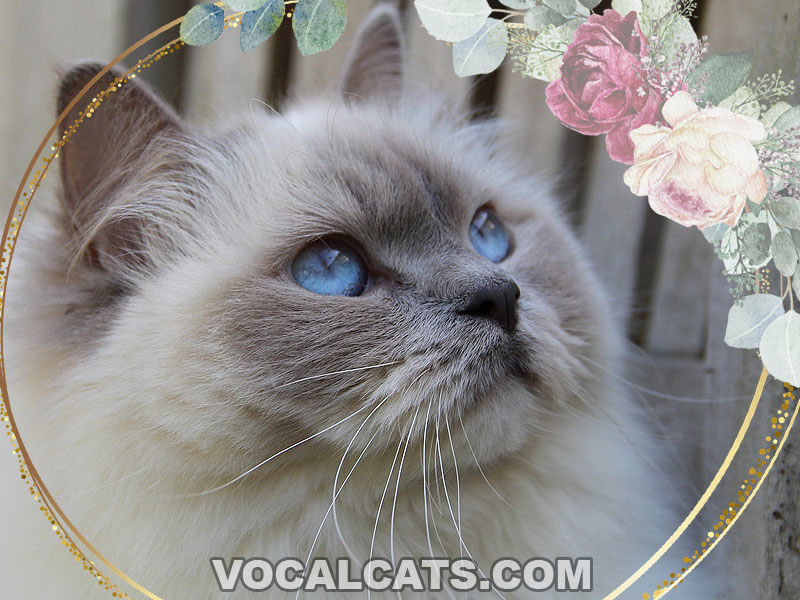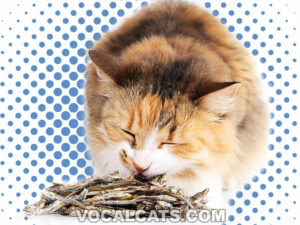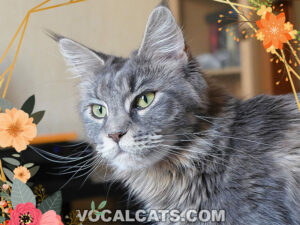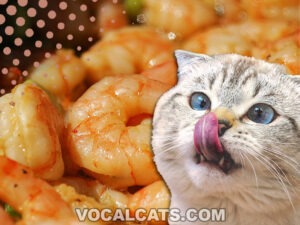The Grey Ragdoll Cat isn’t just beautiful to look at, he also possesses a sweet and docile nature. If you’re looking for a feline friend that loves his human companions and is ideal for families with kids or pets, look no further than the Grey Ragdoll.
But before you get one, it’s always best to do in-depth research on any pet you intend to bring home. And that’s where we come in. We’ve compiled an all-in-one guide about the Gray Ragdoll Cat (also known as the Blue Point Ragdoll by some) to help readers, like yourself, make an informed decision.
Our comprehensive guide includes details about the Grey Ragdoll Cats’ genetics, temperament, diet, caretaking, and much more. We’ve also included a list of breeders you can reach out to. So, without further ado, let’s first start with the breed overview.
Contents
- Grey Ragdoll Cat: Breed overview
- Can Ragdoll Cats be Grey?
- What is a Grey Ragdoll Cat?
- Are Grey Ragdoll Cats rare?
- Gray Ragdoll Cat genetics
- Grey Ragdoll physical appearance
- Do all Grey Ragdoll Cats have blue eyes?
- Are Gray Ragdoll Cats born white?
- Is Grey a recognized Ragdoll Cat color?
- Various Gray Ragdoll colors and patterns
- Grey point Ragdoll size, height, and weight
- Grey Ragdoll Cat personality and temperament
- Ragdoll Cat Grey training
- Ragdoll Grey exercise requirement
- Ragdoll Grey Cat grooming and cleaning
- Solid Grey Ragdoll Cat food and diet
- Grey Ragdoll Cat health issues
- Grey Ragdoll Cat lifespan
- Grey Ragdoll Cat breeder
- Grey Ragdoll kitten
- Grey Ragdoll Cat price
- Places to find Grey Ragdoll kittens for sale
- Finding a healthy Grey Ragdoll Cat for sale
- Grey Ragdoll Cat rescue and adoption
- Mixed Grey Ragdoll Cat breeds
- Grey Maine Coon Ragdoll Mix
- Grey Ragdolls: Pros and Cons
- Is the Grey Ragdoll Cat right for me?
Grey Ragdoll Cat: Breed overview
If you’re short on time, here is the Grey Ragdoll overview section for some quick facts. These stats include size dimensions, lifespan, and other pertinent details.
| Other common Names | Grey Ragdoll |
| Size | Large |
| Weight | 10-20 pounds |
| Height | 9-13 inches |
| Lifespan | 12-15 years |
| Colors | Light to blue Grey, dark Grey points |
| Child Friendliness | High |
| Feline Friendliness | High |
| Training Difficulty | Medium |
| Grooming Upkeep | High |
| Breed Health | Good |
| Exercise Needs | High |
| Kitten Costs | $500-$5,000 |
Can Ragdoll Cats be Grey?
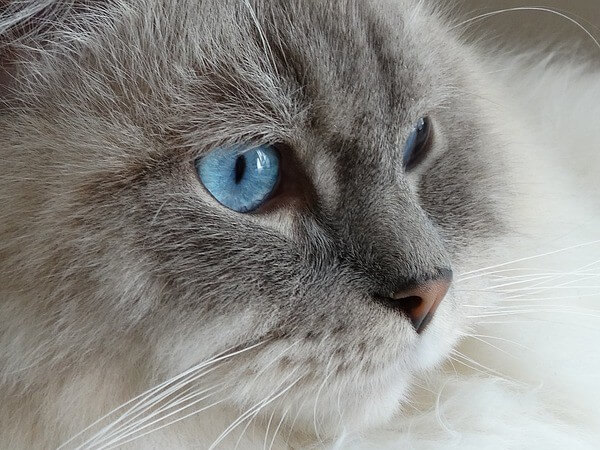
Yes, Ragdoll Cats are available in the color Grey. That’s because the Ragdoll breed comes in various patterns and hues. The Cat Fanciers’ Association(CFA) recognizes six (6) official colors in the breed standard.
These include the following:
- Chocolate.
- Lilac.
- Red.
- Cream.
- Blue.
- Seal.
This confuses a lot of newbie Ragdoll fans because they do not mention the color Grey.
You should note, however, that the technical term for Grey within the standard Ragdoll is blue. So, if you’re searching for Grey Ragdoll Cats, you will often be redirected to Blue Point Ragdolls or simply Blue Ragdoll Cats on the internet. It is a jargon that most breeders and judges use for Grey Ragdolls.
What is a Grey Ragdoll Cat?
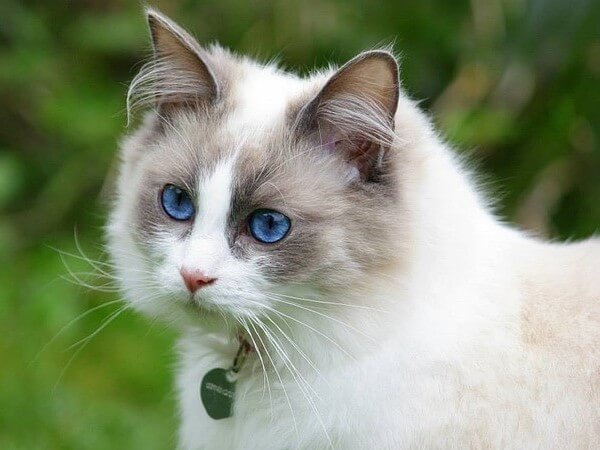
The Grey Ragdoll Cat is renowned for its distinctive light Grey coat color. According to breeding experts, Grey (technically blue) in the Ragdoll breed is a dilution of the more dominant seal and chocolate colors. Grey (or Blue) Ragdolls are available in various patterns, including color point, mitted, and bicolor.
These cats aren’t very different from other Ragdoll breed in terms of size and temperament. Grey Ragdoll Cats (or Blue) are large-sized felines with medium to long hair coats. Their fur is soft and they sport fluffy tails.
Full pedigree Ragdolls also have the trademark oval-shaped blue eyes. They make excellent pets for families with young children due to their gentle nature. Grey Ragdolls are also good with other animals and aren’t aggressive.
DON’T MISS: Chocolate Pointed Ragdoll (Complete Guide)
Are Grey Ragdoll Cats rare?
No, Grey Ragdolls are not rare. In fact, Grey is one of the more popular shades among the Ragdoll breed. As stated earlier, Grey is a dilution of dominant colors like seal and chocolate colors.
CHECK OUT: Seal Point Ragdoll (Complete Guide)
Breeding experts claim you have the highest chance of getting Blue Ragdoll kittens when both parents are Blue Ragdolls. Combining the genes of Blue and Lilac Ragdolls can also produce a litter with Grey Ragdoll kittens.
Gray Ragdoll Cat genetics
Breeders have had to work on Ragdoll genetics to ensure the occurrence of specific colors. The gene that decides pigmentation in the Ragdoll breed has two likely alleles.
These include ‘B’ for Black, ‘b’ for chocolate, ‘D’ for density, and ‘d’ for dilution.
Generally, blue and lilac kittens are part of a litter where both parents carry the dilution ‘d’ gene.
Genetic tests reveal that Grey is a dilute of the black pigment. Felines with the D/d genotype carry the dilution gene. If two felines with the D/d genotype mate, then the mother cat can product a litter with 25% of the kittens have the dilute color.
On the other hand, cats with the d/d genotype display dilute colors, and mating two cats of this genotype will result in all dilute color kittens.
Grey Ragdoll physical appearance
Grey Ragdolls are pretty similar to other variations in the Ragdoll breed, except for their color. They have medium-to-long coat that is soft to the touch and have fluffy tails. They are also large-sized and can weigh up to 20 pounds.
The primary coat color for this variation can range from light to blue-gray. The points (cold areas of the body, such as the ears, snout, tail, and paws) are generally darkish-Grey.
The Grey fluffy Ragdoll Cat also sports the hallmark blue eyes of the Ragdoll breed. The combination of Grey fur only makes their eyes appear brighter and more beautiful.
Do all Grey Ragdoll Cats have blue eyes?
Yes, all purebred Grey Ragdolls have blue eyes. According to The International Cat Association (TICA), a traditional Ragdoll needs to have blue eyes to be recognized as such by breed standards.
If you see an adult Grey Ragdoll Cat with blue eyes, you can be sure of its pedigree and bloodline. Although, cat enthusiasts should remember that all Ragdoll kittens are born with blue eyes. If they maintain the blue eye color after three months, they will retain blue eyes all throughout their lives.
If your search history contains the term Grey Ragdoll Cat green eyes, it’s best to note that Ragdolls with green or yellowish eyes are generally mixed breeds. Such felines might share blood with Sepia, Solid, or Mink Ragdolls.
You may be interested in: Blue Eyed White Ragdoll (Complete Guide)
Are Gray Ragdoll Cats born white?
Yes, all Ragdoll kittens are born white at birth, therefore purebred Gray Ragdoll Cats are born white. They only begin to develop during the first few months of their lives.
However, some Ragdolls can take up to a few years to fully mature in coat color.
Is Grey a recognized Ragdoll Cat color?
Blue or Grey is a recognized coat color of the Ragdoll breed, according to the breed standards of The Cat Fanciers’ Association (CFA). Although, the technical term for Grey is ‘blue’ in most Ragdoll standards.
Various Gray Ragdoll colors and patterns
This section is for you if you’re interested in learning more about the various colors and patterns among the Grey Ragdoll. Scroll below to learn more.
Grey and white Ragdoll Cat
The Ragdoll Grey and white variation is popular among cat enthusiasts thanks to its unique looks. A Grey White Ragdoll Cat has a light Grey body with white markings on its cheeks, chin, chest, and legs.
Besides that, a white and Grey Ragdoll is relatively similar in size to other Ragdolls. You can also expect a Gray and white Ragdoll Cat to have bright blue-colored eyes. This signifies that the Grey and white Ragdoll is pedigreed and isn’t a mix.
As for Grey and white Ragdoll kittens, they are white at birth with blue eyes. When a white and Grey Ragdoll kitten is at least three months old and his blue eye color has not changed, then you can be sure that he is a purebred.
You should also note that it might take a Ragdoll kitten Grey and white a few weeks to develop his coat colors. However, some cats can take longer to develop their coat colors.
Temperament-wise, the white and Grey Ragdoll Cat is peaceful and docile. You can also expect your Ragdoll white and Grey to get along well with other pets in your home. These felines aren’t aggressive and don’t go looking for trouble. The Ragdoll Cat Grey and white is also safe around young children as they are not prone to hissing or scratching.
CHECK OUT: Do Ragdoll Cats Scratch Furniture?
Dark Grey Ragdoll Cat
Dark Grey Ragdolls are distinct from Grey Ragdolls in that their coat color is a richer and deeper Grey. However, the color of their underbellies and chest area are somewhat lighter than the rest of their fur.
Besides that, the dark Grey Ragdoll Cat have blue eyes and generally do not have any coat patterns.
Blue Grey Ragdoll Cat
Blue Grey Ragdoll Cats have a Greyish-white body that is closer to white. This makes them resemble Blue and white Ragdolls quite a bit. These felines also have dark Grey points (extremities like masks, ears, paws, and tails).
Black and Grey Ragdoll Cat
Black and Grey Ragdolls mostly have black coats combined with Grey fur.
Grey tabby Ragdoll
The Grey Tabby Ragdoll has a Grey coat with black markings (almost like tiger-stripes) running down the length of the feline’s body from the head to the back.
RECOMMENDED: Ragdoll Tabby Mix (Complete Guide)
Grey mitted Ragdoll
Grey Mitted Ragdolls can have a white blaze in the shape of an hourglass, diamond, or star located in any place between their foreheads or nose leather. They have white chins with the white extending to their bellies in a stripe.
The Grey mitted Ragdolls sport the mitted pattern on all four legs. Their paws are white and it looks like they are wearing mittens. However, the pattern extends to the wrist joints on the front legs and goes up to the hocks on the hind legs.
RELATED: Blue Mitted Ragdoll (Complete Guide)
Grey point Ragdoll size, height, and weight
Generally, male and female Ragdolls don’t differ much in size and weight. More often than not, the differences in height and weight are minimal and a matter of an inch or two.
Here are the size and weight details of the Grey Ragdoll Cat.
| Height | Weight | Length | |
| Male | 9-13 inches | 15-20 pounds | 17-21 inches |
| Female | 9-12 inches | 10-15 pounds | 17-20 inches |
Grey Ragdoll Cat personality and temperament
Grey Ragdolls have the outstanding Ragdoll temperament. These feline companions are relaxed and laid-back. They prefer to spend their days lazing around and observing what’s happening around them.
Grey Ragdolls are also highly even-tempered and get along well with all family members, including adults and kids. They’re also exceptionally well-behaved around other pets and animals.
Unlike other cat breeds, Grey Ragdolls do not get distressed very easily.
They tolerate changes in their routine without too much of a reaction. Finally, they make excellent fuzzy companions for apartment dwellers as they are not high-energy cats and do not require a lot of space.
Ragdoll Cat Grey training
Grey Ragdolls are easier to train compared to other cat breeds. If your kitten isn’t housetrained when you bring him home, don’t fret! It won’t be that difficult to train him to use the litter.
Housetraining the breed will require you to carry your kitten to the litter after every meal and giving him the time and space to inspect and smell the litter box.
DON’T MISS: Cat Scratching Litter Box Excessively: 10 Reasons Why & What To Do!
Additionally, if you’re planning on teaching your Ragdoll Cat tricks, such as fetch or catch, please know that it will take time, patience, and perseverance. Felines can be quite stubborn and have their individualistic personalities with some being more pliable than others.
If your little fur babies get distracted easily, it is best to break up their training time into several small 2 to 3-minute sessions to keep them from being annoyed.
Investing in a clicker and some quality feline treats to practice positive reinforcement is also a good idea.
Ragdoll Grey exercise requirement
Ragdolls are not high-energy cats. This sometimes makes them susceptible to feline obesity. If you want your Grey Ragdoll to stay healthy and strong, it’s best to take them out for a walk every day for at least 15 minutes. This is one of many great forms of exercise for your feline friends.
It is also possible to break up the 15 minutes into smaller sessions throughout the day to keep your little fur babies from feeling bored.
You can also incorporate play time during their exercise sessions by investing in cat toys. Items like interactive and feather toys are a big hit amongst the Ragdoll breed.
Ragdoll Grey Cat grooming and cleaning
If you’re wondering how much time and effort you would need to devote to caring for a Grey Ragdoll, this next section can help.
Fortunately for you, we’ve compiled a list of essential grooming needs and their frequency for your Ragdolls below.
| Grooming Needs | Grooming Frequency |
| Hair Brushing | 2x weekly. |
| Bathing | Once every 4-6 weeks. |
| Nail Trimming | Every 2 weeks or as required. |
| Teeth Brushing | 2-3x weekly or give dental chews daily. |
| Eye Care | Gently wipe once a day to remove crust or as required. |
| Ear Care | Wipe outer ears as required. |
Solid Grey Ragdoll Cat food and diet
Grey Ragdolls are large-sized felines with a strong bone structure and, therefore, requires a protein-rich diet to maintain their body frame. Experts state that a Ragdoll’s diet should replicate what cats normally consume in the wild. Their nutritional profile should include 3% carbohydrates, 20% fat, and 50% animal-based protein.
Feline owners can feed their fuzzy friends a combination of wet and dry food. This will help maintain the breed’s water intake to maintain hydration and prevent problems like constipation or bladder stones.
If you’re not sure what is the best food to feed your little Grey Ragdoll, we highly recommend that you consult with your veterinarian to find out the diet best for him or her. Your vet should know specific nutritional needs and health concerns that pertains to your Grey Ragdoll Cat.
RELATED: Can Cats Eat Rotisserie Chicken?
Grey Ragdoll Cat health issues
Grey Ragdolls are generally considered healthy, but they are still susceptible to certain health problems. It is best for prospective owners to be aware of their kitties’ health issues in advance so that they can pick up on the red flags and book a timely visit to the vet.
Below are 5 health issues that Grey Ragdolls are most prone to:
1. Polycystic Kidney Disease
Polycystic Kidney Disease (PKD) is an inherited health condition that results in cysts forming in the kidneys. This is a congenital condition which means that the cysts are present at birth.
As your four-legged friends grows, the cysts develop and grow larger over time. Eventually, these cysts interfere with the kidney function and, in extreme cases, can lead to kidney failure.
2. Hypertrophic Cardiomyopathy (HCM)
Hypertrophic Cardiomyopathy or HCM is common in Ragdolls and it is due to a genetic mutation. The MYBPC3 gene in Ragdolls is responsible for the development of this heart disease.
It causes the walls of the affected feline’s heart to thicken until the heart muscle is too thick to pump blood efficiently. Symptoms of HCM include lethargy, loss of appetite, and rapid breathing.
3. Cryptococcosis
Cryptococcosis is a fungal disease commonly found in both Siamese and Ragdoll cats. The illness develops due to the C. neoformans fungus. Symptoms of Cryptococcosis includes weight loss, runny nose, ulcerated nose, lethargy, and disorientation.
4. Feline obesity
Ragdolls, like other low-energy cats, are prone to becoming overweight. This can generally occur due to overfeeding or lack of regular exercise. While obesity itself isn’t too much of a health concern, it can lead to secondary health conditions such as arthritis or diabetes.
Therefore, it is best to speak with your vet and ask for a healthy weight-loss program to ensure your feline sheds the extra pounds and find ways to maintain a healthy weight.
5. Hairballs
Ragdolls are long-haired felines and they have a tendency to groom themselves reguarly. One of the ways they groom themselves is by licking their fur. During this process, they may ingest some fur.
Generally, cats will expel the fur in their tummies by vomiting or coughing up the hairballs. However, felines sometimes have trouble expelling the ingested hair and can experience symptoms like lethargy, discomfort, diarrhea, and even intestinal blockage.
Grey Ragdoll Cat lifespan
Grey Ragdolls have an average lifespan of 12 to 15 years. Nonetheless, it is possible for some felines to live longer than 15 years. The oldest living Ragdoll is said to have lived to the ripe old age of 23 years.
Grey Ragdoll Cat breeder
Experts recommend acquiring Ragdolls from reputable and ethical breeders because of the multiple advantages involved. First off, reputable breeders are careful of pedigree. So, if you’re looking for a purebred Grey Ragdoll, going to a responsible breeder means you won’t mistakenly get another color or variation.
Second, breeders ensure their queens and kings (the mating pairs) undergo genetic testing to rule out illnesses. This ensures your fuzzy friends won’t suffer from any congenital health issues.
Third, breeders will also generally provide vaccinated and spayed/neutered kittens, making it easier for you to adjust to your feline friend’s routine and needs.
Grey Ragdoll kitten
Prospective cat owners have the options of getting their Ragdoll Grey kitten from pet stores or from breeders/catteries. Experts recommend going directly to responsible breeders to get your Gray Ragdoll kittens for several reasons.
First off, breeders follow ethical breeding and housing standards which make the cats less likely to be born with illnesses. Breeders will also generally provide genetic test results for any Grey Ragdoll kitten you purchase.
This works as a guarantee that the feline is free of congenital health conditions like polycystic kidney disease or other health issues. Additionally, Grey Ragdoll kittens acquired from catteries are housetrained, vaccinated, and neutered/spayed. This means feline owners can be confident that their kittens are healthy once they arrive to their forever home.
Finally, it’s also a good idea to turn to breeders for Ragdoll kitten Grey if you want to be sure about coat and color claims.
Grey Ragdoll Cat price
Grey Ragdolls from reputable breeders or catteries can cost anywhere from $500 to $5,000. If the kittens’ parents have special traits, you can expect the kittens to be more expensive.
For instance, if a Grey Ragdoll kitten comes from show-cat parents or is a strong pedigree, then he will likely fall within the $1,500 to $5,000 price spectrum. Also note that Grey Ragdoll Cat price can vary based on demand, breeder’s location, and the breed type.
Aside from all that, here are some of the other expenses you’ll need to consider before bringing your Grey Ragdoll kitten home.
| Expense Type | Cost |
| Cat food and treats | $30-$50 |
| Food bowl & water bowl | $15-$20 |
| Cat bed | $15-$35 |
| Carrier | $30-60 |
| Litter tray | $50-$150 |
| Litter | $10-$25 |
| Grooming items | $20-$35 |
| Toys | $15-$50 |
| ID Tag | $10-$20 |
| Vet visits (initial) | $150-$250 |
| Initial shots | $30-$50 |
| Medications (flea, heartworm, etc.) | $40-$150 |
| Neuter/spay procedure | $50-$500 |
| Microchip | $45-60 |
| Initial cost (Total) | $510-$1,405 |
Places to find Grey Ragdoll kittens for sale
If you’re searching for reputable breeders to find your Grey Ragdoll kitten, we can help. In this next section, we’ve listed two certified breeders you can reach out to.
If you’re looking for a Ragdoll breeder that offers nothing but quality, My Champion Heart Ragdolls (mychampionheartragdolls.com/available-kittens) is a good place to start. They are TICA and CFA-certified and have a brilliant collection of well-pedigreed kings and queens.
What’s more, they only separate kittens from their litter after three months and neuter/spay them before delivering them to you.
Based in Massachusetts, Rhetorical Ragdolls (rhetoricalragdolls.com) has been in the Ragdoll business for at least 16 years. They are TICA-certified and meticulous about genetic testing. All of their kittens find their forever loving homes after their initial vaccinations.
Finding a healthy Grey Ragdoll Cat for sale
Holding out for an adult Grey Ragdoll? No problem! Here are some breeders that you can look into as your starting point.
KrystalBlue Ragdolls (krystalblueragdolls.com) is based in Fort Worth and Gilmer, Texas. Their cattery specializes in Seal and Blue Ragdolls in mitted, colorpoint, and bicolor patterns. Their adults Ragdolls are carefully tested before entering into the breeding programs.
READ NEXT: Seal Mitted Ragdoll (Complete Guide)
Another breeder that may have adult Grey Ragdoll is the Rock Creek Ranch Ragdolls (rockcreekranchragdolls.com/retired-breeders). They are based in California and have an impressive selection of Blue (Grey) Ragdolls for sale. All of their adults are retired and are still in the best of health with colorful personalities.
Grey Ragdoll Cat rescue and adoption
If you’re looking to adopt or rescue instead, you can look at these rescue and adoption centers for your Grey Ragdoll.
Check out Merlin’s Hope: Ragdoll Rescue (facebook.com/mhragdollrescue) which is a registered 501c3 rescue center in Ennis, Texas. They specialize in rescuing, rehabilitating, and putting up lovable Ragdolls in Texas.
Another rescue center is Ragdoll Rescue USA (facebook.com/RagdollRescueUSA) which is a not-for-profit rescue organization for Ragdolls from all around the United States.
Mixed Grey Ragdoll Cat breeds
Grey Ragdoll Grey Ragamuffin Cat
As the name suggests, Grey Ragdoll Grey Ragamuffin Cat combines two cat breeds: Ragdolls and Ragamuffins.
The Ragamuffin cat breed’s history is a bit unclear, but it is widely agreed that this cat breed was created by Ragdoll owners. The owners crossed Ragdolls with other cats that are longhaired such as the Persians, Himalayans, Turkish Angoras, and other domestic long-haired felines.
Since blue (Grey) is a recognized color in both breeds, how the Grey Ragdoll Grey Ragamuffin kittens will look depends largely on the parents’ coat color and patterns.
For instance, a blue Ragdoll that mates with a Ragamuffin will most likely have blue Ragdoll kittens.
On the other hand, the patterns can be a combination of color point, mitted, bicolor, chinchilla, or shaded. A mixture of chinchilla and color point can result in a kitten with a white undercoat. The hair on the kitten’s flanks, back, head, and tail can be tipped with light gray fur.
Grey Maine Coon Ragdoll Mix
Grey Maine Coon Ragdoll Mix have soft and thick double coats. Generally, this mixed breed also has blue eyes from their Ragdoll parents. From their Maine Coon relatives, When it comes to their personality and size, the Grey Maine Coon Ragdoll gets his docile personality and large frames from his Maine Coon relatives.
If you’re looking for a gentle giant that loves human company, the Grey Maine Coon Ragdoll is an ideal feline companion.
Grey Ragdolls: Pros and Cons
Do you need some help making up your mind about whether or not to get the Grey Ragdoll Cat? If so, here is a table of pros and cons to help you decide.
| Pros | Cons |
| Intelligent. | Prone to certain illness. |
| Loving. | High initial costs (depending on demand). |
| Playful. | Must always be kept indoors. |
| Good with kids. | Moderate shedding. |
| Non-aggressive. | Non-hypoallergenic. |
| Can easily bonds with human owners. | Requires consistent grooming. |
Is the Grey Ragdoll Cat right for me?
Grey Ragdolls can make the perfect feline companion for families looking for pets to bond with. These felines are loving, affectionate, and docile. However, they do require frequent grooming, healthy nutritional considerations, and regular vet visits.
Ragdolls can also be prone to health problems like feline obesity, diabetes, and intestinal blockage due to hairballs. In short, getting a Grey Ragdoll will work fine if you’re looking to receive love and are ready to offer your time and attention to him or her.
DISCLAIMER: THIS WEBSITE DOES NOT PROVIDE MEDICAL ADVICE
The information, including but not limited to, text, graphics, images and other material contained on this website are for informational purposes only. No material on this site is intended to be a substitute for professional veterinary advice, diagnosis, or treatment. Always seek the advice of your veterinarian or other qualified health care provider with any questions you may have regarding a medical condition.
Resources:
https://en.wikipedia.org/wiki/Ragdoll
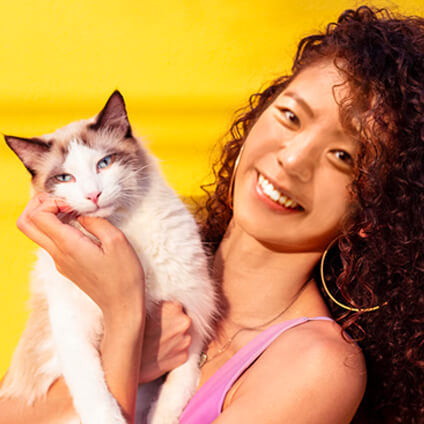
With over five years of specialized experience as an animal writer, my expertise lies in cat nutrition, health, behavior, grooming, and training. I am dedicated to delivering helpful and informative content that caters to the well-being of our feline friends. My primary goal is to empower pet owners with knowledge and ensure our feline companions thrive in health and happiness. In my free time, I love volunteering at local cat rescue centers.
